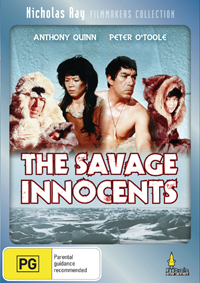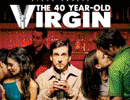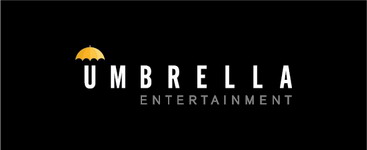The Savage Innocents (Filmmakers Collection) (1960) |
|
The Savage Innocents (Filmmakers Collection) (1960) |
|


|
| BUY IT |
| General | Extras | ||
| Category | Drama | None | |
| Rating |

|
||
| Year Of Production | 1960 | ||
| Running Time | 106:30 | ||
| RSDL / Flipper | No/No | Cast & Crew | |
| Start Up | Ads Then Menu | ||
| Region Coding | 4 | Directed By | Nicholas Ray |
|
Studio
Distributor |
 Umbrella Entertainment |
Starring |
Anthony Quinn Yoko Tani Carlo Giustini Peter O'Toole Marie Yang Marco Guglielmi Kaida Horiuchi Lee Montague Andy Ho Anna May Wong Yvonne Shima |
| Case | Amaray-Transparent | ||
| RPI | $19.95 | Music |
Muir Mathieson Angelo Francesco Lavagnino |
| Video | Audio | ||
| Pan & Scan/Full Frame | Pan & Scan | English Dolby Digital 2.0 (192Kb/s) | |
| Widescreen Aspect Ratio | None | ||
| 16x9 Enhancement | No | ||
| Video Format | 576i (PAL) | ||
| Original Aspect Ratio | 2.35:1 | Miscellaneous | |
| Jacket Pictures | No | ||
| Subtitles | English for the Hearing Impaired | Smoking | No |
| Annoying Product Placement | No | ||
| Action In or After Credits | No | ||
After 1955's Rebel Without A Cause, starring James Dean, the future career prospects of director Nicholas Ray were infinite. Ray had a string of critical hits now after 1954's Johnny Guitar starring Sterling Hayden and Joan Crawford and was planning to make a film on the life of Jesse James with his new favourite star, James Dean. So what happened? Why did Nicholas Ray disappear from mainstream Hollywood? Well, first and foremost, the untimely death of James Dean set Ray back on his ambitions. Secondly, Ray was a uncompromising visionary who also had an addictive personality, he challenged conventional social and filmmaking customs in his films in the 1950s, and while his films were successful he was tolerated, but when they weren't big box office hits, he found himself on the outer.
On the outer is the best way to describe the setting for Ray's 1960 film, The Savage Innocents. Ray by this time was definitely on the outer with mainstream Hollywood, this film struggled to get production funds to get greenlit, and when it did, it was only through a complex British, Italian and French joint conglomeration that impacted on the quality of the film due to locations and cost restrictions. The Savage Innocents continues Ray's favourite theme of the social misfit, in this film Anthony Quinn plays the lead role Inuk, an Inuit Eskimo trying to get by with his life. The interest in the film lies in Inuk's interactions with the 'white man's' culture and his struggle to understand their social conventions and how he can fit into their social customs, or indeed how the white man can fit into the Inuit's customs. Often Quinn voices the line, "I just don't understand the white man" in the film, and in fact this could have been the subtitle of the film, it provides an apt summary of Ray's intentions in directing the film.
Much is made of Peter O'Toole's role in the film. In comparison to his dyed-blonde look in 1962's Lawrence of Arabia (a film which also stars Anthony Quinn incidentally), I could barely recognise him when he first features in the film. He plays a Canadian trooper who tries to hunt down Inuk after he accidentally kills a missionary at a trading post. O'Toole famously requested to have his credits removed after the film was released due to his voice been dubbed, but his role in the film is over-played by critics because he only appears for 25 minutes, there are other poignant scenes which show Inuk's struggle to cope with both his environment and his relations with other Inuit Eskimos and indeed white men.
Ultimately, The Savage Innocents did not prove to be Ray's masterpiece, although it is a brave and unconventional, for the time, piece of filmmaking, in the tradition of Ray's best socially critical works such as Johnny Guitar (the first time a western featured two lead female roles), Rebel Without a Cause (which because of James Dean created a sub-genre of films relating to teenage angst) and Bigger Than Life (co-written with lead actor James Mason and which was a biting social criticism against 1950s suburban conformism). However, I even cringe now, nearly fifty years later with the Inuit custom of wife-swapping, because most historical cultures abhor such a practice, so why this is emphasised in the film, when this was only done on very rare occasions, and usually in combination with indigenous religious practices, probably only supports Ray's extreme point-of-view in the disharmony between the cultures depicted in the film and his criticism of western culture. Besides, by the time of the film, most Eskimo cultures were 'christianised' by missionaries, and these traditions were no longer practiced. Perhaps, blame should be proportioned to the novel that the screenplay was adapted from called Top of The World. The novel was published and written by Hans Ruesch in 1950, who has admitted that he wrote the novel despite never meeting an Eskimo.
Nicholas Ray would sadly go on to direct only two other mainstream films, the famous biblical epic, starring Jeffrey Hunter, 1961's King of Kings (yes, this was the first mainstream film to show Jesus' face) and 1963's 55 Days at Peking, starring Charlton Heston, Ava Gardner and David Niven. Ray collapsed on the set of that film, possibly from exhaustion, and was unable to complete the picture. He continued to teach filmmaking at universities, where he was able to influence future directors such as Wim Wenders and Jim Jarmusch. French New Wave critics and directors Jean-Luc Godard and Francois Truffaut, through their film criticism work at the French Cahiers du Cinema magazine, esteemed Ray (and Howard Hawks) as one of the great American auteurs of the 1950s, and Martin Scorsese also has acknowledged Ray's cinematographic influence in his films through his unique use of colour.
Some interesting points of trivia about this film include Bob Dylan's inspiration for his song, Quinn the Eskimo, which was based on Anthony Quinn's performance in this film, Australian Ed Devereaux playing the part of the pilot, soon (8 years later) to become famous as Matt Hammond in the Australian children's television series, Skippy and Nicholas Stuart providing voice-over narration to explain Inuit traditions during the film. This voice-over narration technique was rare in film for its time because it's used here in the same style as a documentary, rather then the typical commentary provided by the main character of a film.
I must include a final word on the film rating of PG. Please consider this carefully if you intend to show this film to minors as breasts are exposed in the film and the sexual themes of the film would perplex adults, let alone children. A rating of M would have been more accurate.
This is a direct port of the Region 2 2007 ITV release of the film and the transfer is significantly poor. The transfer has been cropped from its original anamorphic scope ratio and contains many, many instances of dust, dirt and specks on the original negative from which the DVD transfer was sourced.
The Savage Innocents was shot on Super Technirama 70, which was a 35mm film process which allowed for optical enlargement to 70mm. The original aspect ratio of the film is 2:35:1, this transfer has been cropped to 1:33:1, possibly for television viewing purposes. This is a travesty as there is so much of the image lost, with many scenes showing the wide arctic environment, and often faces, arms and bodies are cropped in scenes also.
The film is not as sharp as it could be because it is presented on a single layered DVD. At 106 minutes in length, this should present compression problems in the transfer, with low level noise, but there aren't many instances of this because there are so few night scenes showing dark blacks, the majority of the film is shot depicting the daytime, indoor igloo scenes or outdoor snow and ice.There is one significant instance of macro-blocking at 22:20. As it stands, the average bitrate of the film is a consistent 5.1 mb/sec, barely going below 4.5 mb/sec or above 6 mb/sec at any point throughout the film.
The film's cinematographers Peter Hennessy and Aldo Tonti continue Ray's fine tradition of shooting with rich colours, however this transfer doesn't do the cinematography any justice.
Film artefacts are abundant, both negative (white) and positive (black). These are numerous in every scene of the film in the first 15 minutes, an then less so as the film continues. This may again be a problem with the original negative of the film as the Region 2 Eureka Masters of Cinema release (according to DVDbeaver) also contains transfer issues in the first 15 minutes of the film. Major film artefacts are evident at 1:35, 2:26, 3:06, 3:22, 4:44, 4:53, 5:40, 7:36, 8:28, 9:45, 14:23, 16:23, 17:48, 19:48, 20:25, 20:34, 21:23, 22:51, 23:30, 24:19, 33:45, 36:47, 37:47, 38:33, 39:50, 42:09, 46:05, 46:28, 47:04, 50:17, 51:01, 51:22, 51:37, 57:27, 59:24, 60:26, 61:30, 62:47, 65:13, 65:21, 72:17, 75:41, 78:13, 81:16, 83:20, 83:58, 87:05, 90:22, 95:46, 96:17, 96:50, 98:10, 98:24, 98:36, 98:53, 100:50, 101:02, 101:19, 101:40, 102:19, 102:46, 104:50 and 105:45. Telecine wobble occurs during the opening and closing credits. There are a few instances of interlacing also in scenes depicting wildlife.
Subtitles for the Hard of Hearing are presented in translucent white, making it easy to read for the viewer.
There is no RSDL change because the film is presented on a single layered DVD.
| Sharpness | |
| Shadow Detail | |
| Colour | |
| Grain/Pixelization | |
| Film-To-Video Artefacts | |
| Film Artefacts | |
| Overall |
Just like the video transfer, the audio transfer of the film has faults with many instances of audio clicks, dropouts and background hiss. Significant clicks and dropouts occur at 2:33, 7:46, 7:51, 12:33, 23:04, 26:13, 34:02, 37:48, 47:08, 51:22, 59:03, 71:33, 82:01, 98:58 and 105:45.
There is one English Dolby Digital 2.0 mono soundtrack encoded at 192 kbps.
The Audio is synchronised as well as can be expected for a film that was dubbed, with French and Italian actors having their dialogue dubbed in English.
Angelo Francesco Lavagnino provides a good orchestral score which brings the arctic scenery to life. Juxtaposed to this is the rock'n'roll music that is played as part of the soundtrack when Inuk and his wife are at the trading post and at the end of the film when Inuk and the trooper part ways, which is pivotal to the main theme of the film. I suppose Ray's creative intention here was to point out the innocence of the Eskimo way of life and contrast the Western cultural encroachment upon the Eskimo as being out of place with their beautiful and natural environment.
The soundtrack is mono, therefore there is no surround channel usage.
The Subwoofer is not utilised.
| Dialogue | |
| Audio Sync | |
| Clicks/Pops/Dropouts | |
| Surround Channel Use | |
| Subwoofer | |
| Overall |
There is censorship information available for this title. Click here to read it (a new window will open). WARNING: Often these entries contain MAJOR plot spoilers.
NOTE: To view non-R4 releases, your equipment needs to be multi-zone compatible and usually also NTSC compatible.
The Savage Innocents has been released in a Region-free version by Eureka Masters of Cinema in 2006. This version contains the original 2:35:1 aspect ratio, a commentary by David Ehrenstein and Bill Krohn and a 24 page booklet. The video transfer is also much better than the Region 4 Umbrella and Region 2 ITV release.
As mentioned before, ITV have also released this film in 2007. That Region 2 United Kingdom release is identical to the Umbrella Region 4 release.
Unfortunately, the Eureka version of The Savage Innocents has gone out of print due to a dispute over film rights, however this version remains the version of choice for fans of the film, or of Nicholas Ray's work.
The Savage Innocents comes to DVD in Region 4 with a terrible video and audio transfer and with no extras. Since this is the only version available, together with the identical Region 2 ITV release from 2007, fans of Nicholas Ray's cinematic work will have to settle for this poor pan-and-scan release of a brave, unique and unconventional film for it's time.
If you can find a copy of the 2006 Eureka Masters of Cinema release of The Savage Innocents, hold onto it as this is the only known DVD release of the film with it's original 2:35:1 aspect ratio.
| Video | |
| Audio | |
| Extras | |
| Plot | |
| Overall |
| Review Equipment | |
| DVD | Sony BDP-S550 (Firmware updated Version 019), using HDMI output |
| Display | Samsung LA46A650 46 Inch LCD TV Series 6 FullHD 1080P 100Hz. Calibrated with THX Optimizer. This display device is 16x9 capable. |
| Audio Decoder | Sony STR-K1000P. Calibrated with THX Optimizer. |
| Amplification | Sony HTDDW1000 |
| Speakers | Sony 6.2 Surround (Left, Front, Right, Surround Left, Surround Back, Surround Right, 2 subwoofers) |